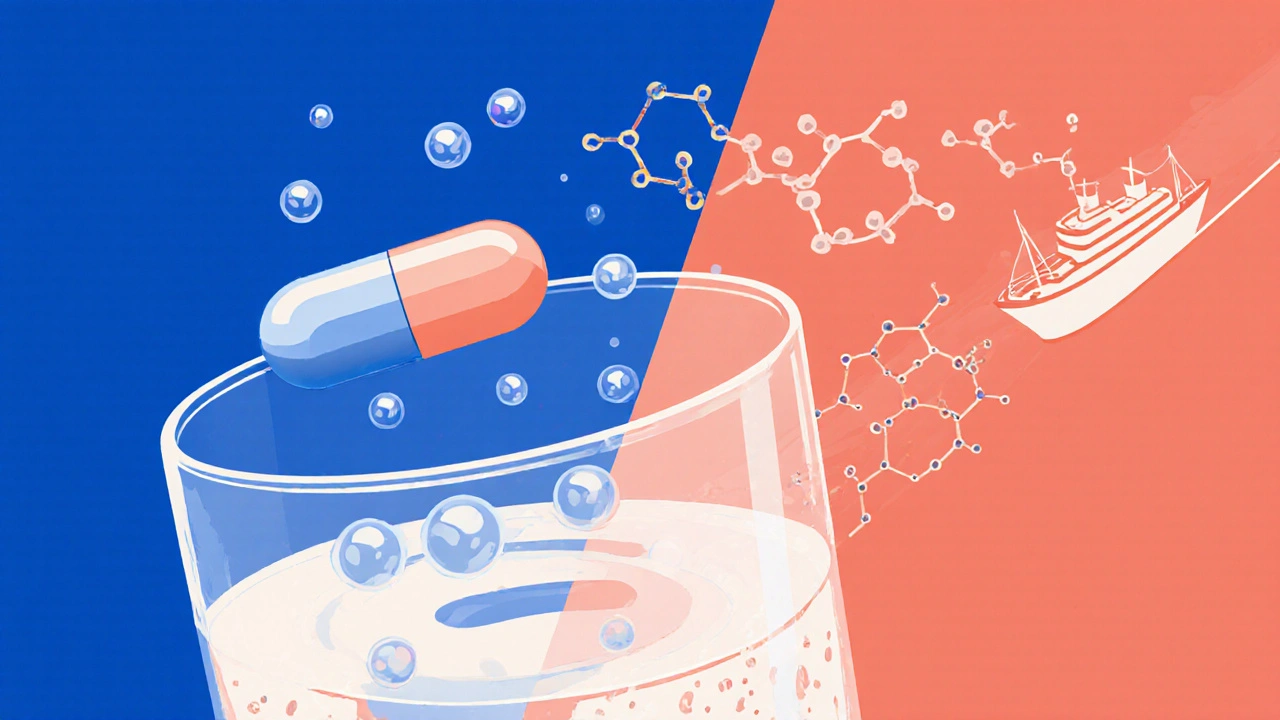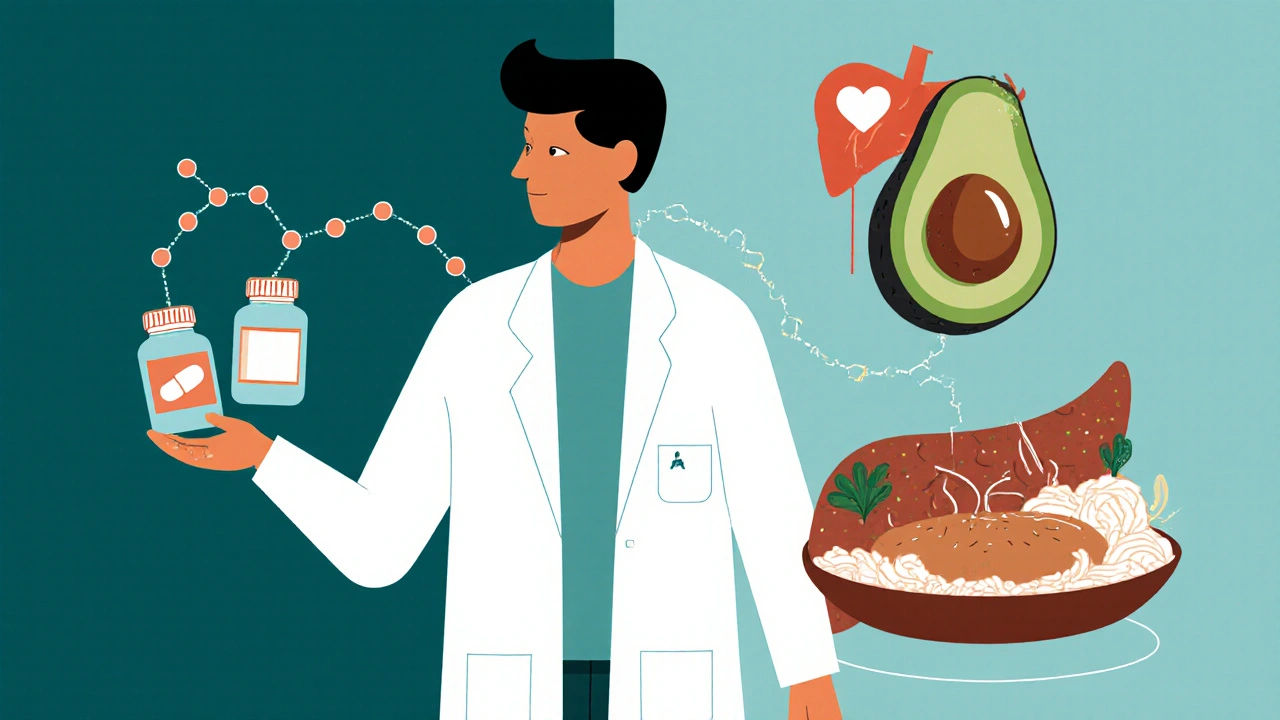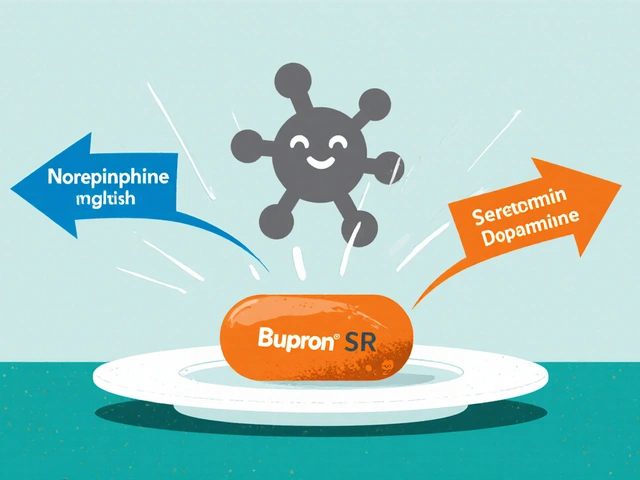
Medication Absorption Improvement Calculator
Lipid-based drug formulations can dramatically improve absorption for poorly water-soluble medications. Enter your current absorption percentage to see how much better it could be with a lipid-based formulation.
When you take a pill with a meal, you might think it’s just about avoiding an upset stomach. But for some medications, what you eat isn’t just helpful-it’s essential. Fatty foods don’t just satisfy hunger; they can dramatically change how well your body absorbs certain drugs. This isn’t folklore or old wives’ tales. It’s science. And it’s behind some of the most effective modern medicines you’re likely to take.
Why Fat Matters for Some Pills
Not all medications work the same way. About 70% of new drugs being developed today don’t dissolve well in water. These are called poorly water-soluble drugs. If a pill can’t dissolve, your body can’t absorb it. That means even if you swallow the right dose, you might get almost none of the benefit. That’s where fat comes in. When you eat fatty foods, your body releases bile and digestive enzymes. These turn dietary fats into tiny droplets that trap drug molecules like a sponge soaking up water. This process, called solubilization, keeps the drug dissolved long enough for your intestines to absorb it. Without fat, these drugs might just pass through you-untouched. This isn’t new. Doctors noticed it decades ago. Patients taking cyclosporine (a drug used after organ transplants) were told to take it with food. Why? Because without fat, absorption dropped by up to 50%. The same was true for fenofibrate, used to lower triglycerides. Later, scientists didn’t just accept it-they engineered it.Lipid-Based Formulations: When Science Turns Food Into a Delivery System
Modern medicine didn’t just rely on meals. It learned from them. Today, dozens of drugs are deliberately formulated with fats, oils, and surfactants to mimic the body’s natural response to a fatty meal. These are called lipid-based drug delivery systems. One of the most common types is called SEDDS-Self-Emulsifying Drug Delivery Systems. These come in soft gel capsules and contain a mix of medium-chain triglycerides (MCTs), surfactants like Tween 80, and small amounts of alcohol-like solvents. When you swallow them, they mix with your digestive juices and form tiny droplets-100 to 300 nanometers wide-that carry the drug directly into your bloodstream. The science behind this is precise. MCTs (from coconut or palm oil) break down faster than long-chain fats. That means they start working within 15 to 30 minutes, while regular fats take over an hour. Faster breakdown = faster drug release. That’s why drugs like Sporanox (itraconazole) for fungal infections use MCT-based formulas. The liquid version gives you 2.8 times more drug in your blood than the capsule-even on an empty stomach.How Much Better Is It?
The numbers don’t lie. For drugs that struggle to dissolve, lipid-based versions can boost absorption by 20% to over 300%. Take fenofibrate: the lipid-based Tricor® delivers 31% more drug into your system than the older, non-lipid version, Lopid®. That means lower doses, fewer pills, and less stomach upset. A 2022 study found 87% of patients preferred Tricor® because they didn’t need to take it three times a day anymore. Cyclosporine is another example. The original Sandimmune® required strict timing with high-fat meals. The newer Neoral® formulation, which uses lipid technology, works just as well whether you eat or not. Patients no longer had to plan meals around their pills. That’s a huge quality-of-life improvement. For drugs like itraconazole, the lipid-based oral solution increases bioavailability so much that it eliminates the 40% variability caused by food. That’s critical for treating life-threatening infections where missing a dose can mean treatment failure.
Not All Drugs Benefit-And Some Can Be Harmful
Lipid-based delivery isn’t magic. It only helps drugs that are poorly soluble but still able to cross cell membranes (BCS Class II and IV). For drugs that dissolve easily (BCS Class I), adding fat does nothing-or even hurts. Bisphosphonates, used for osteoporosis, need stomach acid to dissolve. A fatty meal delays stomach emptying and raises pH, making these drugs less effective. Even worse, some patients can’t process fats well. People with cystic fibrosis, Crohn’s disease, or those who’ve had gallbladder removal may not produce enough bile. For them, lipid-based drugs might not work at all. That’s why experts warn: this isn’t a one-size-fits-all solution.Cost, Convenience, and Real-World Trade-offs
There’s a catch. Lipid-based formulations are expensive. Sporanox oral solution costs about $1,200 for a 30-day supply. The generic capsule? Around $300. That’s a fourfold price difference. Many patients can’t afford it. Insurance doesn’t always cover the branded version, even if it’s more effective. Manufacturing is also harder. These formulations need special packaging-usually soft gel capsules that resist heat and moisture. They’re more sensitive to storage conditions. A pill that sits in a hot car might lose potency. Traditional tablets? They’re stable, cheap, and easy to ship. Still, the trend is clear. In 2015, only 15% of new oral drugs for poor solubility used lipid delivery. By 2023, that jumped to 35%. Oncology, immunology, and antiviral drugs are leading the charge. Why? Because many of these drugs are too complex to dissolve any other way.
What Should You Do?
If you’re on a medication that’s known to have a food effect-like cyclosporine, itraconazole, or fenofibrate-read the label. Some say "take with food." Others say "take on an empty stomach." Don’t guess. Follow the instructions exactly. If you’re prescribed a lipid-based version, understand why. It’s not just a fancy brand name. It’s designed to make your treatment work better. If cost is an issue, talk to your pharmacist. Sometimes, switching to a generic version with a high-fat meal can be a safe, cheaper alternative. And if you’re on a low-fat diet for health reasons-say, for heart disease or weight loss-don’t assume you can skip fat with your pills. Ask your doctor. You might need to adjust your diet slightly to make the medicine work.The Future: Smart Capsules and Personalized Delivery
The next wave of lipid-based delivery isn’t just about mixing oil and drugs. It’s about intelligence. Researchers at MIT developed a prototype capsule that monitors pH and enzyme levels in your gut in real time. It adjusts when and how much drug it releases based on your body’s actual state. Companies like Matinas BioPharma are already testing enzyme-triggered systems that only release drugs when specific digestive enzymes are present. Their amphotericin B formulation achieved 92% bioavailability-nearly triple what traditional versions could do. Even sustainability is being addressed. The European Federation for Pharmaceutical Sciences is pushing for plant-based oils instead of fish-derived lipids to reduce environmental impact. This isn’t science fiction. It’s the future of medicine: personalized, efficient, and designed around how your body actually works.Bottom Line
Fatty foods aren’t just for energy-they’re a key part of how your body absorbs certain medications. Lipid-based formulations have turned this natural process into a powerful tool. They’re not perfect. They’re not cheap. But for drugs that otherwise wouldn’t work, they’re a game-changer. If you’re taking one of these medications, understand the role fat plays. Don’t treat it as an afterthought. It’s part of the treatment.Do all medications need fatty foods to work?
No. Only drugs that are poorly water-soluble benefit from fat. These are typically classified as BCS Class II or IV. Most common medications like antibiotics, pain relievers, or blood pressure pills dissolve easily and don’t need fat. Always check your prescription label or ask your pharmacist.
Can I take lipid-based medications on an empty stomach?
It depends. Some lipid-based formulations, like Neoral® or Sporanox® oral solution, are designed to work without food. Others still require a high-fat meal to trigger the body’s natural absorption process. Never assume-always follow the dosing instructions on your prescription or consult your doctor.
Why are lipid-based drugs more expensive?
They’re more complex to make. They require specialized oils, surfactants, and soft gel capsules that are sensitive to heat and moisture. Manufacturing costs are 25-35% higher than regular tablets. Plus, many are still under patent, so generic versions aren’t available yet.
Can I use olive oil or avocado to help my pill absorb better?
For some older medications that require food, yes-a small amount of healthy fat (like half an avocado or a tablespoon of olive oil) can help. But for modern lipid-based formulations, adding fat yourself won’t replicate the precise chemistry built into the drug. Don’t try to substitute. Use the formulation as designed.
What if I have trouble digesting fats?
If you have conditions like cystic fibrosis, Crohn’s disease, gallbladder removal, or chronic pancreatitis, your body may not produce enough bile or enzymes to activate lipid-based drugs. Talk to your doctor. Alternative formulations, like injectables or non-lipid oral versions, may be needed.
Are there any side effects from taking fatty foods with these medications?
Generally, no. In fact, many patients report fewer stomach issues with lipid-based versions because they don’t need high doses or multiple daily doses. However, if you’re on a strict low-fat diet for medical reasons, adding fat might conflict with your treatment plan. Always discuss dietary changes with your healthcare provider.
Eleanora Keene
This is such a game-changer. I never realized how much fat actually helps with drug absorption. My mom takes cyclosporine and she used to stress about planning meals around her pills. Now she just eats avocado toast and calls it a day. Science is wild like that.
Also, the part about SEDDS? Mind blown. It’s like the drug is riding a fat-powered surfboard straight into your bloodstream. No wonder those new formulations work so much better.
Thanks for breaking this down so clearly. I’m sharing this with my entire family.
Joe Goodrow
Of course fat helps absorption. America’s been eating grease for a reason. We don’t need fancy lab-made capsules. Just eat a burger with your pill. Problem solved. Why are we paying $1200 for a bottle of oil in a gel cap when a Whopper does the same thing? This is corporate greed dressed up as science.
Don Ablett
It is interesting to observe that lipid-based delivery systems exploit physiological mechanisms evolved to process dietary lipids. The enterohepatic circulation and micelle formation are not merely coincidental adaptations but rather foundational to pharmaceutical bioavailability. One might argue that modern pharmacology has merely repurposed ancient biological pathways. The efficiency gains are undeniable, though the cost-benefit ratio remains contentious in public health contexts.
Further research into bile acid receptor modulation may yield even more targeted delivery systems without requiring dietary fat intake.
Kevin Wagner
Y’all are overcomplicating this. This isn’t rocket science-it’s biology. Your body knows what to do. Fat? Good. Water-soluble drugs? Meh. Lipid-based? YES. Why are we still fighting this? If your pill needs fat, eat a spoonful of peanut butter. Done. No fancy capsules, no $$$, no drama.
And if you’re too lazy to eat something real with your meds? Then maybe you’re not ready to be healthy anyway. Stop blaming Big Pharma. Start eating like your life depends on it-because it does.
gent wood
I appreciate the depth of this explanation, particularly the distinction between BCS classes and the physiological rationale behind lipid-based delivery systems. The data on fenofibrate bioavailability is compelling, and the shift from Lopid® to Tricor® represents a significant clinical advancement.
It is also noteworthy that the improvement in patient adherence, as evidenced by the 87% preference rate, may have broader implications for chronic disease management. The reduction in dosing frequency is not merely a convenience-it is a therapeutic advantage.
That said, the cost disparity remains a serious barrier. I hope regulatory bodies begin to incentivize generic lipid formulations more aggressively.
Dilip Patel
lol america thinks its so smart with its fancy capsules but in india we just take medicine with ghee since forever. why pay 1200 dollars when your grandma knew this 50 years ago? we dont need surfactants and mct oil. just fry your pill in butter and be done with it.
also why is everyone talking about cyclosporine like its new? my uncle had a kidney transplant in 1998 and he ate fried rice with every dose. no one told him about sEDDS. he lived 20 years. problem solved.
western medicine is just reinventing the wheel and charging for the rim.
Jane Johnson
This article is misleading. It implies that lipid-based formulations are universally superior, yet fails to acknowledge that many patients experience nausea or diarrhea from the added oils. The cost differential is not just ‘a catch’-it’s a systemic failure of healthcare equity. Also, ‘eat avocado’ is not a medical recommendation. It’s a lifestyle blog suggestion disguised as science.
And why is there no mention of the environmental cost of palm oil? You mention sustainability in passing but ignore the deforestation linked to MCTs. This is greenwashing with a lab coat.
Peter Aultman
Man I used to take my meds with water like a dumbass. Then I started eating a handful of almonds or some cheese with them and wow. Things actually worked better. No idea why but now I just do it. Honestly I didn’t even know fat was involved until I read this. Feels good to finally understand why my body was being weird.
Also yeah the price thing is wild. I get why they charge more but it’s still ridiculous. Wish insurance would just cover the better version instead of making us choose between food and meds.
Sean Hwang
For real-don’t overthink it. If your pill says ‘take with food,’ eat something with fat. Doesn’t have to be fancy. Eggs. Butter. Peanut butter. Even a little cheese on crackers. That’s it.
And if you’re on something like cyclosporine? Don’t skip the fat. I’ve seen people try to be ‘healthy’ and go low-fat and then wonder why their levels are dropping. Your body needs that fat to grab the drug. It’s not optional.
Also-generic versions with a side of avocado? Totally fine. Save your cash. Don’t let them sell you a $1200 pill when $300 + food works just as well.
Erica Cruz
How is this even new? This is basic pharmacokinetics 101. The fact that this is being presented as some groundbreaking revelation suggests the general public has been completely neglected by medical education for decades. And now we’re paying $1200 to be told to eat a banana with your pill? Please. This is the epitome of medical inflation disguised as innovation. I’m not impressed. I’m angry.
Johnson Abraham
bro just take your pill with butter. that's it. no need for fancy capsules. i take my itraconazole with a spoon of mayo and i'm good. why are we paying for science that my 80 year old grandma figured out in 1972? 🤡
Eleanora Keene
Actually, I just checked with my pharmacist and she said for some lipid-based drugs like Sporanox, adding fat yourself doesn’t replicate the exact micelle structure the capsule creates. So while a spoon of mayo might help, it’s not the same as the engineered delivery system. That’s why the branded version works better on an empty stomach.
So yeah-eat fat if you’re on the old stuff. But if you’ve got the fancy one? Let the science do its job. Don’t turn your kitchen into a pharmaceutical lab.






Write a comment